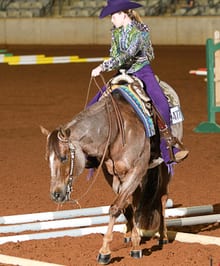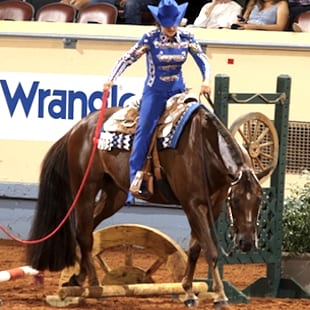Everyone wants to get to the top of the judge’s card when they ride through the gate at the horse show. It is the very reason people show horses. Over the years, scored events have seen tremendous growth. Riders have the undying attention of the judge for as long as it takes to perform their pattern. They like the idea of having the judge’s sole attention, they like the feedback from scored classes and they like to plan when they want to show in the order of go.
The last decade has also seen tremendous growth in the number of classes at a horse show. One thing that has not seen growth however is the number of hours in the day. To compensate for the additional time scored events take and the increase in entries more and more horse shows are going to multiple judges and arenas. Also, horse shows accommodate riders by allowing them to choose when they are going to ride in a particular class, offering “at will” participation in the individually worked classes.
At will draws instead of posted draws provides challenges for management, riders and judges. Judges often end up waiting hours for a single exhibitor to show up to ride their pattern. With long lists of riders and classes, judges can get frustrated waiting on riders to show up – especially when they feel the exhibitor is inhibiting the progress of the show.
Judges get that some riders feel later draws have a competitive advantage. But in large classes, this is just not so. For instance, imagine that you are the judge and you arrive at the horse show at 7:30, walk the trail course, get your score sheets set up and see that you are scheduled to see 150 trail horses that day. You wait for thirty minutes before you see a single horse ride the course. A few horses dribble in through the course of the morning. By this time you have found out more than you should about your ring steward, their siblings, children, horses, dogs and hobbies.
Around noon, the stream of horse has finally gotten steady. Now you have seen 40 horses in approximately four hours. A mere 110 horses left to see at noon…. and you were hoping to get a decent meal that night. Oh well. You are grateful for the steady stream of horses. By late-afternoon the averages are better and you have now seen 100 horses ride the exact same course.
 Soon, they all start looking the same. By late day as the sun starts to go down, you have seen the horses go over each obstacle in virtually the same fashion. Very little separates them; they are good movers, extremely well trained, go on a loose rein, clear the obstacle and are well turned out. Earlier in the day, with fresh eyes, it was easier to determine the difference between a plus one-half and a plus one. Now, they look too similar to distinguish. As you wait for the stragglers to dribble in it starts to get cold and dark. The show grounds is deserted and you are left with the ring stewards, some tired and hungry grounds keepers and show management – all waiting for those last few horses – who are also tired and hungry and know they should be back in their stalls.
Soon, they all start looking the same. By late day as the sun starts to go down, you have seen the horses go over each obstacle in virtually the same fashion. Very little separates them; they are good movers, extremely well trained, go on a loose rein, clear the obstacle and are well turned out. Earlier in the day, with fresh eyes, it was easier to determine the difference between a plus one-half and a plus one. Now, they look too similar to distinguish. As you wait for the stragglers to dribble in it starts to get cold and dark. The show grounds is deserted and you are left with the ring stewards, some tired and hungry grounds keepers and show management – all waiting for those last few horses – who are also tired and hungry and know they should be back in their stalls.
Although sometimes that last horse can be the best one you have seen all day, in most instances, that is simply not the case. Rarely does the last horse beat the impressions made earlier when the judge’s eyes were fresh, horses were happy and riders were unrushed.
With the increased popularity of scored events, the number of entrants can be intimidating to many exhibitors. Each rider strategizes over how to try to maximize their score. When horse shows allow random order draws where you go in the draw is a major consideration.
As you prepare for some of the biggest events of the season, keep in mind that no matter where you draw up, first, middle or last, your job is to maximize your presentation. If given a choice when riding in a very large class, try not to wait too long before showing. You have a better chance of making a winning impression earlier in the draw. That does not mean that if you draw up at the end of a posted order you cannot make your working order work for your advantage.
Just don’t get stuck on draw order. Judges are constantly undergoing training and part of that training is recognizing winners whenever they go: first, middle or last. If given a choice try to go earlier rather than later. And most importantly, don’t make judges wait – especially at the end of an already too long day. You want to have the judge’s favor. Everyone shows under the same circumstances. Be courteous to everyone and respectful of other people’s time: show management, judges and fellow competitors included. You will end up with good favor and better results.
About Stephanie Lynn: Professional Horseman Stephanie Lynn coached her first AQHA World Champion in 1988. She has since coached, trained and shown World, Congress and Honor Roll horses across disciplines. She is a judge for AQHA, NSBA and APHA and has judged World Championship shows for each association. Most recently, Stephanie is the author of The Good Rider Series and A Lifetime Affair: Lessons Learned Living My Passion. The Good Rider Series is a library of resource material that is both practical and applicable in the barn and show ring for riders. Stephanie can always be reached through her website: http://www.stephanielynn.net to answer your questions, schedule a clinic or lesson.
Photos © American Quarter Horse Journal









